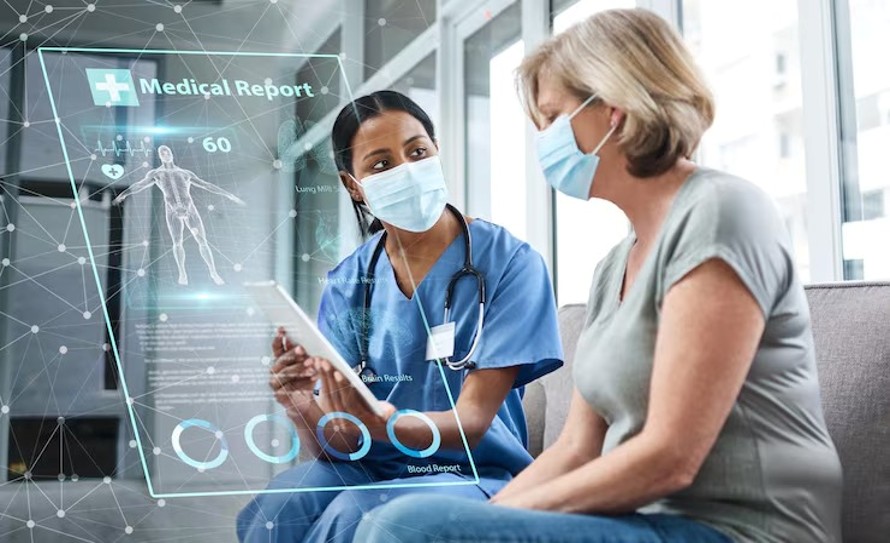
@ShahidNShah


AI is radically changing the healthcare industry, and the patient care revolution through technology is practically at the door. AI-powered predictive analytics enables doctors to anticipate health risks, identify trends at an early stage, and provide care that is data-validated through the use of AI. This proactive method indeed elevates the standard of treatment, but it also simplifies the administration and lowers the total healthcare expenses. As digital transformation grows, hospitals are also turning to Healthcare SEO Services to enhance visibility for their advanced care innovations.
The concept of predictive analytics is to utilize past health data combined with complex algorithms to find out the patterns that can facilitate the prediction of future health conditions. Healthcare providers generate a large amount of data from electronic health records, diagnostic imaging, laboratory tests, and wearable devices. AI systems digest this data to find the relationships that humans might miss.
One example of the use of predictive analytics is the identification of the patients who are the most likely to develop chronic diseases, be rehospitalised, or not follow their medication routines. By using these data, healthcare professionals can become involved earlier, thus the problem has not become worse, which is a win-win scenario for patient health and the healthcare system.
Risk prediction tools enable healthcare providers to uncover risk factors in their initial stages. For instance, a healthcare facility might utilize AI to analyse patient records and lab results for diagnosing some patients who are likely to develop diabetes or congestive heart failure without noticing any symptoms.
To create therapy plans adapted to one’s genes, age, and habits, AI tools can come up with treatment possibilities by analysing thousands of medical records. This tailor-made method heightens the effectiveness of the treatment and lowers the risk of over-treatment.
Hospital situations are typically unplanned requests for services. Predictive analytics are able to project patient admissions as well as manage labour so that the appropriate resources can be allotted at the specified time.
Predictive models for the post-discharge time stipulate those patients who will come back within 30 days so that the medical staff can continue the treatment, and also organize the preventive measures of readmission.
Reduced hospital stays, improved patient care, and streamlined workflows each save the health system money. In all, this represents a win for both the dollar and the quality of care.
Healthcare organisations can rely on predictive analytics to provide them with a solid ground for their decisions. Doctors using up-to-date information can foresee the development of the illness and select the treatment that will be both successful and prompt. Thus, predictive models in cancer treatment are capable of generating what will be the best reactions to the drugs in use, consequently assisting the physicians in making the right decision on the way to go.
Moreover, analytics that are powered by AI are a significant tool for population health management. The health systems will be able to identify the groups of people that are the most vulnerable and develop practical wellness programs that will not only reduce the risk of chronic diseases but also alleviate these communities’ small areas of chronic illnesses.
The role of Healthcare SEO in the marketing of these technologies cannot be underestimated, as it is instrumental in the dissemination of information about such developments by the medical institutions and in attracting awareness of their online progress.
Among the primary applications of predictive analytics is healthcare, through which patient care has been deeply enhanced.
These types of implementations show how the use of data-driven decision-making can transform the provision of healthcare services to be a patient-centric, personalised form.
Eventually, the accuracy of predictive analytics will increase as more data is gathered and computing power becomes more available.
The combination of genomics, wearable devices, and IoT technology will allow for health risk predictions to be made at a level of high precision.
Going forward, patients could have AI-based living instructions delivered to their smart mobile devices, and at the same time, the medical staff will be using predictive performance boards to handle the health of entire communities effectively. The main objective is a health care system that saves lives by early detection rather than fighting diseases.
The use of AI-based predictive analytics is radically changing the management of patient care. The entire healthcare sector stands to benefit enormously from the array of applications that range from early detection, personalised treatments, and the smooth running of healthcare facilities. With time and the perfection of the technology, providers will not only be able to make the right decisions, but they will also save more lives and provide preemptive care.
Social media alone will never suffice to support these advancements. Medical facilities should communicate their technology journeys just as vigorously. A well-planned medical digital campaign, supported by carefully researched content and Virtual Assistance services, can ensure that the attention-grabbing potential of healthcare analytics is effectively showcased.

Skin cancer continues to be one of the most diagnosed cancers worldwide, yet its treatment options are evolving faster than ever before. Conventional therapies such as surgery and radiation remain …
Connecting innovation decision makers to authoritative information, institutions, people and insights.
Medigy accurately delivers healthcare and technology information, news and insight from around the world.
Medigy surfaces the world's best crowdsourced health tech offerings with social interactions and peer reviews.
© 2025 Netspective Foundation, Inc. All Rights Reserved.
Built on Dec 24, 2025 at 11:26am